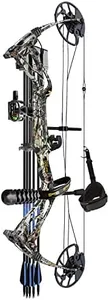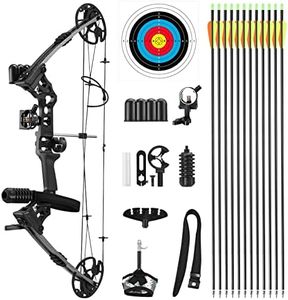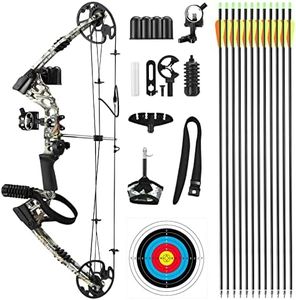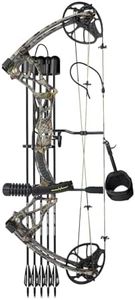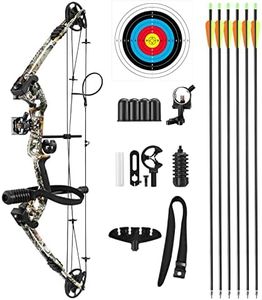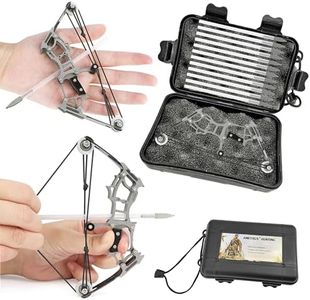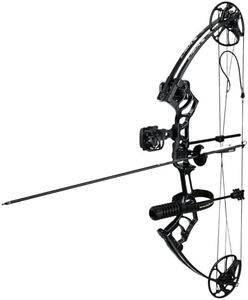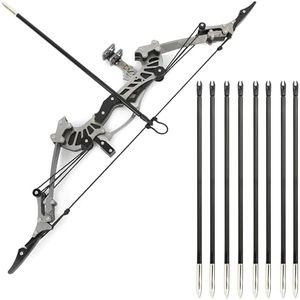We Use CookiesWe use cookies to enhance the security, performance,
functionality and for analytical and promotional activities. By continuing to browse this site you
are agreeing to our privacy policy
10 Best Compound Bows
From leading brands and best sellers available on the web.Buying Guide for the Best Compound Bows
Choosing the right compound bow is important for both beginners and experienced archers. Each person has different needs based on their size, strength, intended use (such as hunting or target shooting), and personal preferences. When picking a compound bow, you should consider how comfortable it feels, how well it matches your physical abilities, and whether it suits your style of shooting. Instead of focusing only on popular brands or looks, focus on the technical details that truly affect performance, accuracy, and user experience. The right combination of features will make your practice or hunting trips more enjoyable and effective.Draw WeightDraw weight is the amount of force needed to pull back the string of the bow to its full draw. This is critical because it affects how powerful your shots will be and how comfortable the bow is to use. Draw weights typically range from about 15 to 70 pounds. Lower draw weights (15-35 lbs) are easier to pull and are often chosen by beginners, youth, or those using the bow for target practice. Medium draw weights (35-50 lbs) suit most adults and are appropriate for both target shooting and beginner hunting. Higher draw weights (50-70 lbs) are usually preferred by experienced archers or for serious hunting, where more power is needed to ensure a quick kill. You should select a draw weight that you can handle comfortably for repeated shots, prioritizing good form over raw power.
Draw LengthDraw length is the distance between the bowstring's resting position and its fully drawn position. This matters greatly because the bow needs to fit your body size, especially your arm span, for optimal comfort and accuracy. Standard draw lengths range from about 22 to 32 inches. Shorter draw lengths are for people with shorter arms, while longer draw lengths suit those with longer arms. Most bows allow some adjustment in this area, but selecting the correct draw length is critical—if it's too short or too long, you'll struggle with consistency and accuracy. To find your ideal draw length, measure your arm span and use that as a guide or consult an archery technician for a precise fit.
Axle-to-Axle LengthAxle-to-axle length is the distance between the two cams (the wheels at the end of the limbs) when the bow is at rest. This spec determines how large the bow is physically and influences its stability, balance, and maneuverability. Short axle-to-axle lengths (less than 32 inches) make the bow more compact and easier to handle in tight spaces like thick woods, but they may be less forgiving of small errors. Medium lengths (32-36 inches) strike a balance, while longer bows (over 36 inches) are often chosen for target shooting since they offer greater stability and accuracy over longer distances. Think about where you’ll use the bow most—narrow spaces or open fields—and choose a length that fits those scenarios.
Let-OffLet-off is the percentage of weight reduced when the bow is fully drawn, thanks to the bow's cam system. For example, on a bow with a 70-pound draw weight and 80% let-off, you only have to hold 14 pounds at full draw. This makes it easier to aim steadily for longer periods. Let-off typically ranges from 65% to 90%. Lower let-off means you must hold more weight while aiming, which is more challenging, while higher let-off allows you to hold much less, making it easier to shoot accurately, especially during long hunts or competitions. Choose the let-off that matches your comfort—high let-off if you value holding steady on target, lower if you prioritize a different shooting feel.
Brace HeightBrace height is the distance between the grip (the bow's handle) and the string. This spec influences how forgiving the bow is of mistakes. Short brace heights (less than 6 inches) typically produce faster arrow speeds but require more precise technique. Longer brace heights (over 7 inches) are more forgiving and easier for beginners or those with developing form. For most people, a middle or slightly higher brace height creates a more enjoyable shooting experience with fewer missed shots caused by mistakes in technique.
Bow WeightBow weight is simply how heavy the bow is to hold and carry. Lighter bows (under 3.5 pounds) are easier to carry for long periods, making them good for hunting or younger shooters. Heavier bows (over 4 pounds) often feel steadier and can aid in accuracy, especially for stationary target shooting, but may tire your arms more quickly. Consider how far and often you'll be carrying the bow—if mobility is key, go lighter. If stability during shooting is your main goal, a slightly heavier bow might help.
